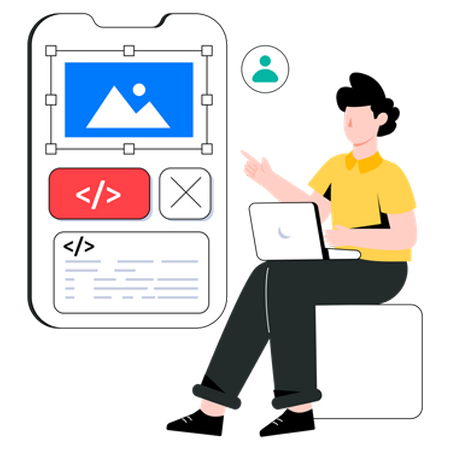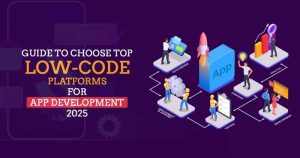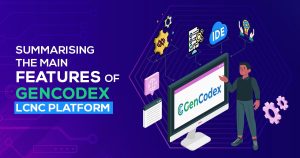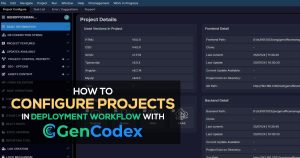Table of Contents
In today’s fast-moving digital world, being able to change and come up with new ideas is very important for businesses of all sizes. However, building software the traditional way can take a lot of time, money, and specialized knowledge, which can be a challenge for many organizations. That’s where no-code platforms come in as a revolutionary tool that allows people to create and customize applications without needing to know how to write code.
This cutting-edge technology makes it possible for anyone, including those without technical skills, to take charge of their projects. Whether you want to improve your team’s workflow, boost teamwork, or turn your creative ideas into reality, no-code platforms provide amazing opportunities for creativity and efficiency.
No-code is an innovative approach to developing and utilizing applications without requiring programming skills or writing code. As part of the self-service movement, no-code platforms enable business users to create, manage, and implement data-driven applications, enhancing their efficiency and productivity.
In this blog, we will examine what no-code technology is, its advantages, and how it is transforming software development. Join us to learn how you can use no-code solutions to maximize your team’s potential and speed up your journey into the digital age.
What is No-Code Development?
No-code development is a visual programming methodology that allows non-technical users to design applications by leveraging a drag-and-drop interface. This approach eliminates the need for traditional coding, making app development accessible to a broader audience.
With no code, anyone can create the applications they need without prior coding knowledge. This accessibility has positioned no-code as a transformative force in the future of software development.
On the other hand, low code is already a well-established reality, reshaping the industry and garnering significant attention.
What Are No-Code Technologies?
No-code platforms allow users without programming expertise to develop essential business applications through an intuitive graphical interface. By utilizing drag-and-drop elements, business users can create applications independently, removing the reliance on software developers.
Who Are No-Code Developers?
No-code developers are individuals who build software applications using no-code platforms without writing traditional code. They come from diverse backgrounds and possess varying levels of technical proficiency. These developers include business analysts looking to automate tasks, entrepreneurs building custom solutions, and small business owners creating their own software.
Key Stakeholders in No-Code Development
No-code platforms are gaining traction among various professionals due to their ability to enhance workflows and empower non-technical users. The key beneficiaries include:
Digital Transformation Experts (DT Experts): No-code enables DT experts to rapidly prototype and launch digital solutions, improving operational agility and market responsiveness.
Process Owners: These individuals use no-code tools to automate tasks, design custom workflows, and streamline processes, enhancing efficiency and reducing errors.
Departmental Heads: Functional leaders leverage no-code to create tailored applications that address specific departmental needs, including data management, customer relations, and internal communications.
What Is the No-Code Approach?
No-code empowers non-programmers to develop critical business applications using a visual interface. By leveraging drag-and-drop tools, users can build web and apps without needing to write a single line of code.
“Low-code and no-code technologies place efficiency directly into the hands of modern professionals, enabling them to create solutions, automate workflows, and expand their skillsets effortlessly.” — Melody Brue, Principal Analyst, FinTech, Forbes.
How Is Low-Code Different from No-Code?
While low-code has been a part of the industry for years, its theoretical foundations date back even further. Many IT professionals have encountered low code in some form, whether as high-level programming languages like Python and SQL or as an abstraction of software development.
Low-code and no-code platforms employ multiple levels of abstraction to simplify application development:
1. Internal/Capability Level: Defines the core features and functional limits of the platform, including built-in integrations and available modifications.
2. Logical/Behavioral Level: Determines how different elements within the application interact and function together, covering automation and integration features.
3. External/User Level: Involves application outputs, data processing, and user interface modifications based on real-time usage.
Low-code platforms provide customizable code blocks that developers can use to tailor applications, allowing greater flexibility. However, no-code platforms are ideal for pre-defined use cases where extensive customization isn’t required.
Advantages of No-Code Development
No-code platforms offer several benefits, including:
1. Focus on Core Application Needs: By abstracting technical complexities, no-code allows developers to prioritize user experience and customer engagement.
2. Reduced Development Costs: Traditional software development requires hiring specialized personnel. No-code eliminates many of these costs, making development up to 80% more affordable.
3. Elimination of IT Backlogs: No-code platforms empower business departments to develop their own applications, reducing reliance on IT teams.

Key Features of No-Code Development
No-code development platforms have changed how people and businesses create websites and apps by allowing anyone to build them without coding skills. This makes technology more accessible and inspires creativity. Here are some key features that make the no-code platform unique:
1. Drag-and-Drop Interface:
No-code platforms offer an intuitive, user-friendly drag-and-drop interface that simplifies application creation. Users can select and place elements visually, such as buttons, forms, and navigation menus, without needing to write any code. This feature speeds up the development process and makes app building accessible to non-technical users, empowering business professionals and entrepreneurs to create functional applications with ease.
2. Built-In Data Connectivity:
Many no-code platforms come with pre-configured databases or provide seamless integration with external data sources, such as cloud storage services, spreadsheets, and APIs. These platforms often include visual data mapping tools, enabling users to connect and manage data without requiring SQL or backend development skills. This ensures smooth data flow between different parts of an application, facilitating real-time updates and automation.
3. Visual Modeling Tools:
Instead of writing code, users can design applications by assembling pre-built components like forms, workflows, and dashboards through visual modelling tools. These tools often include logic builders, automation rules, and condition-based triggers, allowing users to define application behaviour using a graphical interface. This approach accelerates development, reduces errors, and enables rapid prototyping and iteration, making it easier to adapt to changing business needs.
4. Compatibility with multiple platforms
No-code platforms are designed to work smoothly on a variety of devices, such as desktops, smartphones, and tablets. This means that users will have a consistent experience, no matter what device they’re using. It’s perfect for businesses that want to reach a wide audience without the hassle of extra development work.
5. Pre-Built Templates and Components
These tools come with ready-made templates and components that help users kickstart their projects easily. With options suitable for different industries, users can quickly customize these templates to fit their needs, making it much faster to get things up and running.
6. Cost Efficiency
No-code platforms help businesses save money and time by eliminating the need for deep coding skills and simplifying the development process. This allows companies to use their budgets more wisely, concentrating on innovation and growth instead of hiring large development teams.
Related: Main Features of the GenCodex AI-based LCNC Platform
Getting Started with No-Code Development
To start with no-code technology, first identify your project’s needs to choose the right tools. Next, select a no-code platform that aligns with your goals and learn about its layout and features to improve the building process. To begin with no-code technology, follow these steps:
1. Explore Available Platforms: Research different no-code platforms, such as Bubble, Adalo, or OutSystems, to compare their unique features, pricing, and capabilities. Choose one that aligns with your project needs.
2. Sign Up for a Trial: Many platforms offer free trials or freemium plans, allowing users to test their features, experiment with sample projects, and assess the ease of use before committing to a paid plan.
3. Start Building: Leverage pre-built templates, drag-and-drop tools, and visual editors to create your first application. Start with a simple project, such as a task manager or a form-based app, to get comfortable with the platform.
4. Test and Iterate: Use built-in debugging tools, user feedback, and testing environments to refine your app. Optimize performance, fix issues, and enhance user experience before launching.
5. Launch and Maintain: Deploy your application to a live environment and monitor its performance. Regularly update it with new features, security patches, and user-driven improvements.
What Can You Build with No-Code?
No-code platforms enable rapid development of various applications, including:
1. Workflow Automation: Automate repetitive tasks, streamline approvals, and reduce manual data entry using rule-based workflows and integrations with third-party services.
2. Custom Dashboards & Reports: Consolidate business data into real-time analytics dashboards, visualize key performance metrics, and generate automated reports for decision-making.
3. Data Integration Solutions: Connect multiple business applications, such as CRMs, ERPs, and cloud storage, to create seamless data synchronization and automation.
4. Knowledge Management Systems: Build centralized repositories for company documentation, FAQs, and training materials, ensuring efficient knowledge sharing among employees.
5. Incident Management Tools: Create ticketing systems for customer support, track internal IT issues, and automate notifications for faster resolution of problems.
6. Compliance & Security Monitoring: Develop applications to monitor regulatory compliance, audit logs, and security alerts, ensuring adherence to industry standards.
7. Resource Management Applications: Optimize asset tracking, personnel scheduling, and inventory management with real-time resource allocation and reporting tools.
Building an App with No-Code
No-code development typically follows three key steps:
1. Design the Interface: Customize the user interface with themes, colours, logos, and navigation elements to align with your brand identity. Utilize responsive design to ensure compatibility across devices.
2. Develop the Features: Use pre-built components, logic workflows, and API integrations to configure functionalities such as form submissions, notifications, and automated processes.
3. Deploy the Application: Publish your app on a web or mobile platform, share it with users, and monitor its performance. Update and scale it as needed to accommodate growing business requirements.

The Role of No-Code in Innovation
No-code platforms democratize software development, allowing non-technical professionals to build applications and drive business innovation. These platforms empower employees closest to operational challenges to develop and iterate on solutions, reducing dependency on IT teams and accelerating digital transformation.
For IT leaders, no-code offers a balance between agility and governance, enabling rapid development while maintaining security and compliance. No-code also fosters experimentation, allowing companies to prototype ideas quickly and cost-effectively.
Why Choose GenCodex for No-Code Development?
GenCodex is a leading no-code platform that simplifies enterprise application development. It offers a user-friendly, cloud-native environment, ensuring scalability and security while empowering teams to create powerful applications without coding expertise.
With GenCodex AI-powered No-Code Development Platform, organizations can bridge the gap between developers and non-technical users, making it a valuable asset in the evolving no-code landscape.




